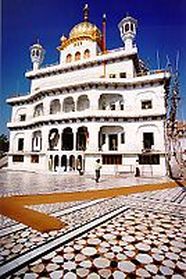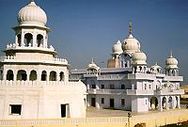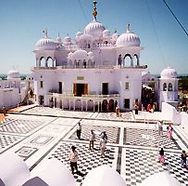
Sri Akal Takht
Akal Takht literally means Eternal Throne. It is part of the Golden Temple complex in Amritsar. The Akal Takht is situated on the other end of the causeway connected to the Harmandir Sahib. It's foundation was laid by Guru Hargobind. It was here that he was ceremonially installed as Guru in 1606. The building of the Akal Takht opposite the Golden Temple has a special meaning. While the Golden Temple stands for spiritual guidance the Akal Takht symbolises the dispensing of justice and temporal activity. During the day the Guru Granth Sahib is kept in the Golden Temple, while at night it is kept in the Akal Takht. The decisions taken at the Sarbat khalsa assemblies held at the Akal Takht and Hukamanamans or decrees issued by the Akal Takht are binding upon all sikhs, all over the world. Harminder Sahib was raised by Guru Arjan Dev ji, right in the middle of Sarovar (holy tank) and its construction was started in 1558. Traditionally all Sikh warriors sought blessings here before going to battle. During the 18th century while Sikhs were fighting a guerrilla war in the forests they used to gather at the Akal Takht on special occasions such as Baisakhi and Diwali. Here the community used to have general meetings and approve resolutions. The Akal Takht was the oldest of the Five Takhts, but it was destroyed by the Indian Army during its military invasion in 1984. It's reconstruction is complete.
Akal Takht literally means Eternal Throne. It is part of the Golden Temple complex in Amritsar. The Akal Takht is situated on the other end of the causeway connected to the Harmandir Sahib. It's foundation was laid by Guru Hargobind. It was here that he was ceremonially installed as Guru in 1606. The building of the Akal Takht opposite the Golden Temple has a special meaning. While the Golden Temple stands for spiritual guidance the Akal Takht symbolises the dispensing of justice and temporal activity. During the day the Guru Granth Sahib is kept in the Golden Temple, while at night it is kept in the Akal Takht. The decisions taken at the Sarbat khalsa assemblies held at the Akal Takht and Hukamanamans or decrees issued by the Akal Takht are binding upon all sikhs, all over the world. Harminder Sahib was raised by Guru Arjan Dev ji, right in the middle of Sarovar (holy tank) and its construction was started in 1558. Traditionally all Sikh warriors sought blessings here before going to battle. During the 18th century while Sikhs were fighting a guerrilla war in the forests they used to gather at the Akal Takht on special occasions such as Baisakhi and Diwali. Here the community used to have general meetings and approve resolutions. The Akal Takht was the oldest of the Five Takhts, but it was destroyed by the Indian Army during its military invasion in 1984. It's reconstruction is complete.

Takht Sri Damdama Sahib
Damdama Sahib is situated in the village of Talwandi Sabo near Bhatinda. This is where Guru Gobind Singh stayed for nearly a year and compiled the final edition of the Guru Granth Sahib known as the Damdama Sahib Bir in 1705. He added to the original version prepared by Guru Arjan Dev Ji the verses of Guru Teg Bahadur Ji. A large number of new converts joined the fold of the Khalsa here. The first Guru Granth Sahib hand written by Guru Gobind Singh resides here.
Damdama Sahib is situated in the village of Talwandi Sabo near Bhatinda. This is where Guru Gobind Singh stayed for nearly a year and compiled the final edition of the Guru Granth Sahib known as the Damdama Sahib Bir in 1705. He added to the original version prepared by Guru Arjan Dev Ji the verses of Guru Teg Bahadur Ji. A large number of new converts joined the fold of the Khalsa here. The first Guru Granth Sahib hand written by Guru Gobind Singh resides here.

Takht Sri Keshgarh Sahib
Keshgarh Sahib is situated at Anandpur. It is considered the birthplace of the Khalsa. The Khalsa order was founded here by Guru Gobind Singh on March 30th 1699. Some of the weapons of Guru Gobind Singh are displayed here. The most precious of these is the actual Khanda (double edged sword) used by Guru Gobind Singh to prepare the amrit (sweet water) used in the first Khalsa initiation ceremony. This is the birthplace of the Khalsa.
Keshgarh Sahib is situated at Anandpur. It is considered the birthplace of the Khalsa. The Khalsa order was founded here by Guru Gobind Singh on March 30th 1699. Some of the weapons of Guru Gobind Singh are displayed here. The most precious of these is the actual Khanda (double edged sword) used by Guru Gobind Singh to prepare the amrit (sweet water) used in the first Khalsa initiation ceremony. This is the birthplace of the Khalsa.

Takht Sri Hazur Sahib
Hazur Sahib is on the banks of Godavari in Maharashtra. This is where Guru Gobind Singh left this world. The inner room of the temple is called Angitha Sahib. Takhat Sachkhand Sri Hazur Abchalnagar Sahib is the principal shrine at Nanded. It marks the site where the Guru had his camp in 1708 A.D. after the departure of the emperor Bahadur Shah. The tenth Guru held his court and congregation here. It is the site of his own tent where he was convalescing after he was attacked by assassins. It is the place from where the tenth Guru rose to heaven along with his horse Dilbag.
In 1708 being prescient of the end of his earthly role, the Guru had despatched Banda Singh with five of his Sikhs to Punjab and Mata Sahib Devan under a separate escort to Delhi before the stabbing incident. He told the rest of his retinue to retire to their homes if they so wished, but he bade one Bhai Santokh Singh to stay on here and keep Guru ka langar going. many others also chose to remain. Together they built a room over the platform where the used to sit while holding his court and installed Guru Granth Sahib on it. They called it Takhat Sahib. Guru Gobind Singh, while conferring Guruship on the holy Book, had himself named Nanded as Abchalnagar (lit. steadfast city) after the first word of a hymn read at random on the occasion.
Sachkhand (lit. region of Truth) had been used by Guru Nanak Dev to mean the abode of God. The present building of the Takhat Sahib was got constructed by Maharaja Ranjit Singh with money, artisans and labour sent from Punjab during early 1830s.Around the same time the Nizam of Hyderabad raised a contingent of Northern Sikhs as part of his army. Most of these men settled permanently in Hyderabad State. Many militant and righteous Hindus embraced Sikhism in the 18th century. The control of Takhat Sachkhand Sri Hazur Sahib, which had formerly passed into the hands of Udasi priests was regained by the Sikhs under the influence of the Singh Sabha Movement of the late nineteenth century. Some of the rituals and ceremonies connected with working are peculiar to this Takhat Sahib. In 1956 an Act was passed by the legislature of Hyderabad under which the management of Takhat Sahib and other historical Gurdwaras was legally placed under a 17 member Gurdwaras Board and a five member Managing Committee.
Hazur Sahib is on the banks of Godavari in Maharashtra. This is where Guru Gobind Singh left this world. The inner room of the temple is called Angitha Sahib. Takhat Sachkhand Sri Hazur Abchalnagar Sahib is the principal shrine at Nanded. It marks the site where the Guru had his camp in 1708 A.D. after the departure of the emperor Bahadur Shah. The tenth Guru held his court and congregation here. It is the site of his own tent where he was convalescing after he was attacked by assassins. It is the place from where the tenth Guru rose to heaven along with his horse Dilbag.
In 1708 being prescient of the end of his earthly role, the Guru had despatched Banda Singh with five of his Sikhs to Punjab and Mata Sahib Devan under a separate escort to Delhi before the stabbing incident. He told the rest of his retinue to retire to their homes if they so wished, but he bade one Bhai Santokh Singh to stay on here and keep Guru ka langar going. many others also chose to remain. Together they built a room over the platform where the used to sit while holding his court and installed Guru Granth Sahib on it. They called it Takhat Sahib. Guru Gobind Singh, while conferring Guruship on the holy Book, had himself named Nanded as Abchalnagar (lit. steadfast city) after the first word of a hymn read at random on the occasion.
Sachkhand (lit. region of Truth) had been used by Guru Nanak Dev to mean the abode of God. The present building of the Takhat Sahib was got constructed by Maharaja Ranjit Singh with money, artisans and labour sent from Punjab during early 1830s.Around the same time the Nizam of Hyderabad raised a contingent of Northern Sikhs as part of his army. Most of these men settled permanently in Hyderabad State. Many militant and righteous Hindus embraced Sikhism in the 18th century. The control of Takhat Sachkhand Sri Hazur Sahib, which had formerly passed into the hands of Udasi priests was regained by the Sikhs under the influence of the Singh Sabha Movement of the late nineteenth century. Some of the rituals and ceremonies connected with working are peculiar to this Takhat Sahib. In 1956 an Act was passed by the legislature of Hyderabad under which the management of Takhat Sahib and other historical Gurdwaras was legally placed under a 17 member Gurdwaras Board and a five member Managing Committee.

Takht Sri Patna Sahib
Patna Sahib is situated in Patna the capital of Bihar. It was here that Guru Gobind Singh was born in 1666 and spent his early years before moving to Anandpur. Besides being the birthplace of Guru Gobind Singh, Patna was also honoured by visits from Guru Nanak as well as Guru Tegh Bahadur.
Patna Sahib is situated in Patna the capital of Bihar. It was here that Guru Gobind Singh was born in 1666 and spent his early years before moving to Anandpur. Besides being the birthplace of Guru Gobind Singh, Patna was also honoured by visits from Guru Nanak as well as Guru Tegh Bahadur.


 RSS Feed
RSS Feed